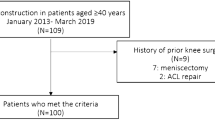Abstract
Purpose
A paucity of data exists on the effects of articular cartilage and meniscal injury in the setting of knee dislocations. The purpose of this study is to determine whether concomitant intra-articular injuries at the time of multiligament reconstruction for knee dislocation are associated with inferior outcomes.
Methods
The records of patients who underwent surgical treatment for multiligament knee injury between 1992 and 2012 were retrospectively reviewed. Patients included had a PCL-based multiligament knee injury or a minimum of three disrupted ligaments, both indicative of knee dislocation. A logistic regression model was used to determine whether articular cartilage injuries (grade 2 involving ≥50 % of the condylar width or greater, or any grade III/IV lesions) and meniscus tears are predictors of IKDC outcome scores collected at a minimum of 2 years postoperatively.
Results
Of the 121 patients who met inclusion criteria, 2-year minimum follow-up was available on 95 patients (79 %). The cohort was 77 % male and had a median age of 32 years (16–62) at the time of surgery and was followed for an average of 6 years. Articular cartilage injury was present in 40 % of knees: medial femoral condyle (20 %); medial tibial plateau (9 %); lateral femoral condyle (5 %); lateral tibial plateau (4 %); patella (18 %); trochlear (5 %). Meniscal injury was present in 56 % of patients (isolated medial, 22 %; isolated lateral, 22 %; combined, 12 %). IKDC scores were significantly lower for patients with any cartilage damage (p = 0.03), combined medial and lateral meniscus tears (p = 0.02), medial-sided articular cartilage damage (p = 0.03), medial femoral condyle (p = 0.04) and trochlear (p = 0.03) lesions.
Conclusion
Articular cartilage damage and meniscus tears are frequently associated with a knee dislocation. This study showed IKDC scores were significantly lower for patients with cartilage damage or combined medial and lateral meniscus tears at mid-term follow-up of 6 years.
Level of evidence
IV.
Similar content being viewed by others
References
Chahal J, Al-Taki M, Pearce D, Leibenberg A, Whelan DB (2010) Injury patterns to the posteromedial corner of the knee in high-grade multiligament knee injuries: a MRI study. Knee Surg Sports Traumatol Arthrosc 18(8):1098–1104
Claes S, Hermie L, Verdonk R, Bellemans J, Verdonk P (2013) Is osteoarthritis an inevitable consequence of anterior cruciate ligament reconstruction? A meta-analysis. Knee Surg Sports Traumatol Arthrosc 21(9):1967–1976
Cox CL, Huston LJ, Dunn WR, Reinke EK, Nwosu SK, Parker RD, Wright RW, Kaeding CC, Marx RG, Amendola A, McCarty EC, Spindler KP (2014) Are articular cartilage lesions and meniscus tears predictive of IKDC, KOOS, and Marx activity level outcomes after anterior cruciate ligament reconstruction? A 6-year multicenter cohort study. Am J Sports Med 42(5):1058–1067
Enderlein D, Nielsen T, Christiansen SE, Fauno P, Lind M (2014) Clinical outcome after reconstruction of the medial patellofemoral ligament in patients with recurrent patella instability. Knee Surg Sports Traumatol Arthrosc 22(10):2458–2464
Fok AW, Yau WP (2013) Delay in ACL reconstruction is associated with more severe and painful meniscal and chondral injuries. Knee Surg Sports Traumatol Arthrosc 21(4):928–933
Irrgang JJ, Anderson AF, Boland AL, Harner CD, Kurosaka M, Neyret P, Richmond JC, Shelborne KD (2001) Development and validation of the international knee documentation committee subjective knee form. Am J Sports Med 29(5):600–613
Irrgang JJ, Ho H, Harner CD, Fu FH (1998) Use of the International Knee Documentation Committee guidelines to assess outcome following anterior cruciate ligament reconstruction. Knee Surg Sports Traumatol Arthrosc 6(2):107–114
Kaeding CC, Pedroza AD, Parker RD, Spindler KP, McCarty EC, Andrish JT (2005) Intra-articular findings in the reconstructed multiligament-injured knee. Arthroscopy 21(4):424–430
Kowalchuk DA, Harner CD, Fu FH, Irrgang JJ (2009) Prediction of patient-reported outcome after single-bundle anterior cruciate ligament reconstruction. Arthroscopy 25(5):457–463
Michalitsis S, Vlychou M, Malizos KN, Thriskos P, Hantes ME (2015) Meniscal and articular cartilage lesions in the anterior cruciate ligament-deficient knee: correlation between time from injury and knee scores. Knee Surg Sports Traumatol Arthrosc 23(1):232–239
Oiestad BE, Holm I, Aune AK, Gunderson R, Myklebust G, Engebretsen L, Fosdahl MA, Risberg MA (2010) Knee function and prevalence of knee osteoarthritis after anterior cruciate ligament reconstruction: a prospective study with 10 to 15 years of follow-up. Am J Sports Med 38(11):2201–2210
Rotterud JH, Risberg MA, Engebretsen L, Aroen A (2012) Patients with focal full-thickness cartilage lesions benefit less from ACL reconstruction at 2–5 years follow-up. Knee Surg Sports Traumatol Arthrosc 20(8):1533–1539
Rotterud JH, Sivertsen EA, Forssblad M, Engebretsen L, Aroen A (2013) Effect of meniscal and focal cartilage lesions on patient-reported outcome after anterior cruciate ligament reconstruction: a nationwide cohort study from Norway and Sweden of 8476 patients with 2-year follow-up. Am J Sports Med 41(3):535–543
Schenck RC Jr (1994) The dislocated knee. Instr Course Lect 43:127–136
Shelbourne KD, Jari S, Gray T (2003) Outcome of untreated traumatic articular cartilage defects of the knee: a natural history study. J Bone Joint Surg Am 85-A(Suppl 2):8–16
Smith JP 3rd, Barrett GR (2001) Medial and lateral meniscal tear patterns in anterior cruciate ligament-deficient knees. A prospective analysis of 575 tears. Am J Sports Med 29(4):415–419
Spindler KP, Warren TA, Callison JC Jr, Secic M, Fleisch SB, Wright RW (2005) Clinical outcome at a minimum of five years after reconstruction of the anterior cruciate ligament. J Bone Joint Surg Am 87(8):1673–1679
Theologis AA, Haughom B, Liang F, Zhang Y, Majumdar S, Link TM, Ma CB, Li X (2014) Comparison of T1rho relaxation times between ACL-reconstructed knees and contralateral uninjured knees. Knee Surg Sports Traumatol Arthrosc 22(2):298–307
Widuchowski W, Widuchowski J, Koczy B, Szyluk K (2009) Untreated asymptomatic deep cartilage lesions associated with anterior cruciate ligament injury: results at 10- and 15-year follow-up. Am J Sports Med 37(4):688–692
Author information
Authors and Affiliations
Corresponding author
Rights and permissions
About this article
Cite this article
King, A.H., Krych, A.J., Prince, M.R. et al. Are meniscal tears and articular cartilage injury predictive of inferior patient outcome after surgical reconstruction for the dislocated knee?. Knee Surg Sports Traumatol Arthrosc 23, 3008–3011 (2015). https://doi.org/10.1007/s00167-015-3671-z
Received:
Accepted:
Published:
Issue Date:
DOI: https://doi.org/10.1007/s00167-015-3671-z




